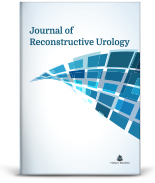Amaç: Malign etiyolojiye bağlı üreteral obstrüksiyonu olan hastalarımızda polimerik, orta kısmı güçlendirilmiş tümör stenti deneyimlerimizin değerlendirilmesidir. Gereç ve Yöntemler: Eylül 2017- Kasım 2019 tarihleri arasında malign üreteral obstrüksiyon sebebi ile üreteral tümör stenti yerleştirdiğimiz hastaların dosyaları ve bilgisayar kayıtlarını retrospektif olarak değerlendirdik. Çalışmamızın tamamı, malign üreteral obstrüksiyon tanısı konulmuş, standart 'double J (DJ)' stent ile hidronefrozu gerilemeyen, kreatinin seviyeleri azalmayan, sık üriner enfeksiyon geçiren hastalardan oluşmaktaydı. Çalışmanın primer hedefi, tümör stentinin etkinlik ve dayanıklılığını değerlendirmek olarak belirlendi. Hastaların, cinsiyet, yaş, altta yatan hastalıklar, önceki radyoterapi, operasyon geçmişi, lateralite yönünden demografik özellikleri değerlendirildi. Bulgular: Çalışmamız, yaş ortalaması 61,9±8,0 yıl olan 10'u erkek, 8'i kadın toplam 18 hastadan oluşmaktaydı. Toplam 21 üniteye 7 Fr 26 cm tümör stenti yerleştirilmişti. Tümör stenti takılmadan önceki ortalama serum kreatinin değeri 4,8 ± 1,8 mg/dL olarak hesaplanırken postoperatif birinci haftadaki ortalama kreatinin değeri ise 1,6 ± 0,5 mg/dL olarak hesaplandı (p<0,001). Ortalama stent değişim süresi 8,2 ± 3,7 ay olarak hesaplandı. Preoperatif 13 renal ünitede şiddetli, 4 renal ünitede orta, 4 renal ünitede de ılımlı hidronefroz mevcuttu. Genel olarak hesaplandığında %80,95 renal ünitede hidronefroz derecesinde azalma saptandı. Sonuç: Tümör stenti, malign üreteral obstrüksiyona bağlı hidronefroz ve kreatinin tedavisinde etkili bir seçenektir.
Anahtar Kelimeler: Tümör stenti; hidronefroz; üreteral obstrüksiyon
Objective: We aimed to evaluate our polymeric medium strengthened tumor stent experiences in our patients with ureter occlusion due to malignant etiology. Material and Methods: We retrospectively evaluated the files and computer records of patients who had a ureteral tumor stent due to malign ureteral obstruction between September 2017-November 2019. All of our study consisted of patients diagnosed with malignant urethral obstruction, did not regress hydronephrosis with a standard double J (DJ) stent, did not decrease creatinine levels and had frequent urinary infections. The primary goal of the study was determined to evaluate the efficacy and durability of the tumor stent. Demographic features of patients in terms of gender, age, underlying diseases, previous radiotherapy, operation history, and laterality were evaluated. Results: Our study consisted of 18 patients, 10 male and 8 female, with an average age of 61.9 ± 8.0 years. A total of 21 units had a 7 Fr 26 cm tumor stent placed. The mean serum creatinine value before the tumor stent was calculated as 4.8 ± 1.8 mg/dL, while the mean creatinine value at the postoperative first week was 1.6 ± 0.5 mg/dL (p<0.001). The mean stent replacement time was calculated as 8.2 ± 3.7 months. Severe hydronephrosis was present in 13 renal units preoperatively, moderate in 4 renal units and mild in 4 renal units. When calculated in general, a decrease in hydronephrosis degree was detected in 80.95% renal unit. Conclusion: Tumor stent is an effective option in the treatment of increased hydronephrosis and creatinine due to malignant urethral obstruction.
Keywords: Tumor stent; hydronephrosis; ureteral obstruction
- Lange D, Bidnur S, Hoag N, Chew BH. Ureteral stent-associated complications--where we are and where we are going. Nat Rev Urol. 2015;12(1):17-25. [Crossref] [PubMed]
- Hung SC, Chiang NI, Huang CY, Pu YS. The effectiveness and durability of ureteral tumor stent, the National Taiwan University Hospital experience. Urological Science. 2017;1-4. [Crossref]
- Russo P. Urologic emergencies in the cancer patient. Semin Oncol. 2000;27(3):284-98.
- Miyaoka R, Hendlin K, Monga M. Resistance to extrinsic compression and maintenance of intraluminal flow in coil-reinforced stents (Silhouette Scaffold Device): an in vitro study. J Endourol. 2010;24(4):595-8. [Crossref] [PubMed]
- Goldsmith ZG, Wang AJ, Ba-ez LL, Lipkin ME, Ferrandino MN, Preminger GM, et al. Outcomes of metallic stents for malignant ureteral obstruction. J Urol. 2012;188(3):851-5. [Crossref] [PubMed]
- Nagele U, Kuczyk MA, Horstmann M, Hennenlotter J, Sievert KD, Schilling D, et al. Initial clinical experience with full-length metal ureteral stents for obstructive ureteral stenosis. World J Urol. 2008;26(3):257-62. [Crossref] [PubMed]
- Chow PM, Hsu JS, Wang SM, Yu HJ, Pu YS, Liu KL. Metallic ureteral stents in malignant ureteral obstruction: short-term results and radiological features predicting stent failure in patients with non-urological malignancies. World J Urol. 2014;32(3):729-36. [Crossref] [PubMed]
- Damiano R, Oliva A, Esposito C, De Sio M, Autorino R, D'Armiento M. Early and late complications of double pigtail ureteral stent. Urol Int. 2002;69(2):136-40. [Crossref] [PubMed]
- Joshi HB, Newns N, Stainthorpe A, MacDonagh RP, Keeley FX Jr, Timoney AG. Ureteral stent symptom questionnaire: development and validation of a multidimensional quality of life measure. J Urol. 2003;169(3):1060-4. [Crossref] [PubMed]
- Withington J, Wong K, Bultitude M, O'Brien T. The forgotten ureteric stent: what next? BJU Int. 2014;113(6):850-1. [Crossref] [PubMed]
- Joshi HB, Chitale SV, Nagarajan M, Irving SO, Browning AJ, Biyani CS, et al. A prospective randomized single-blind comparison of ureteral stents composed of firm and soft polymer. J Urol. 2005;174(6):2303-6. [Crossref] [PubMed]
- Jones DS, Djokic J, Gorman SP. Characterization and optimization of experimental variables within a reproducible bladder encrustation model and in vitro evaluation of the efficacy of urease inhibitors for the prevention of medical device-related encrustation. J Biomed Mater Res B Appl Biomater. 2006;76(1):1-7. [Crossref] [PubMed]







.: Process List